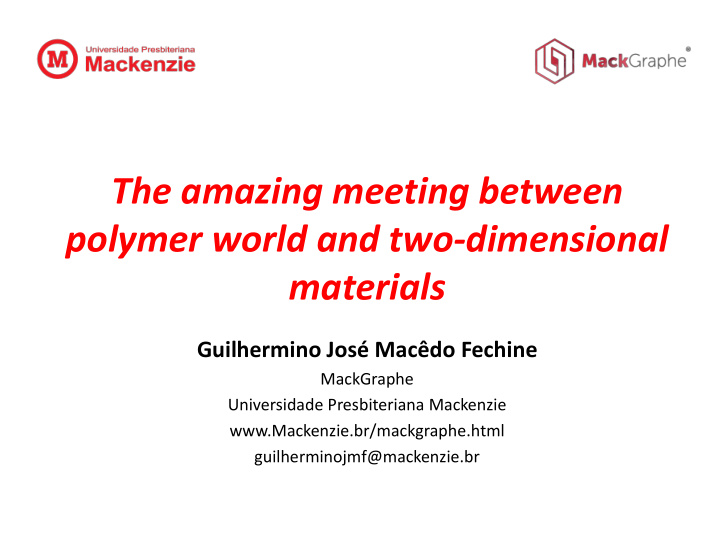



The amazing meeting between polymer world and two-dimensional materials Guilhermino José Macêdo Fechine MackGraphe Universidade Presbiteriana Mackenzie www.Mackenzie.br/mackgraphe.html guilherminojmf@mackenzie.br
Polymers 2D Materials MERO
How did they meet? First date (2004) Wedding Science, V.306, p.666 (2004) (2010) Scotch tape & Graphene Nobel Prize Andre Konstantin Geim Novoselov
How I became friend of the couple? January (2013) Advanced 2D Materials and Graphene Research Centre
Fruits of friendship Chapter one: ”2D Materials Transfer Methods and crystal exfoliation” Chapter two: ”Polymer nanocomposites based on 2D material fillers”
1. Direct Dry Transfer of 2D Materials Challenges I. Large areas of 2D material; II. No etching step; III. No polymer residue; IV. 2D Material integrity.
WET TRANSFER Traditional Method to transfer CVD graphene Wrinkles [1] Cracks [2] Polymer residue [3] [1] Wang et al., Adv. Mater. V.25, p4521 ( 2013) [2] Chen et al., Adv. Sci. V. 3, p. 1500343 (2016). [3] Takashi Matsumae et al. J. Electrochem. Soc. V.163, E159 (2016)
Direct Dry Transfer (DDT) to Polymeric Substrates Patent: US Application No. 14/631,942 (26/02/2015) “ Method and Apparatus for Transferring Graphene to a Polymeric Substrate ”
Phenomena involved Polymer Adhesion Requirements for a good transfer: • Chemical Structure of the Polymer • B polymer-Gr >> B Gr-Cu • Good contact (roughness and rheological properties)
Simulations (PE) (PS) (PLA) (PVDF-TrFE)
Improvements (Rheological properties) LDPE LDPE Complex viscosity (Pa.s) Complex viscosity (Pa.s) HDPE 4 4 1,6x10 1,6x10 HDPE PS PS PLA PLA PVDF-TrFE 4 4 1,2x10 1,2x10 PVDF-TrFE 3 3 8,0x10 8,0x10 3 3 4,0x10 4,0x10 120 120 140 140 160 160 180 180 200 200 o C) o C) Temperature ( Temperature (
Improvements (Contact)
Video
Results (FWHM-2D) DDT DDT-SC HIPS PLA ABS SBS PBAT
2. Direct Dry Transfer by in situ polymerization Patent Appplication (24/02/2016): TRANSFERÊNCIA DIRETA DE MATERIAIS 2D VIA POLIMERIZAÇÃO IN SITU (BR 10 2016 003973 8) FWHM-2D
Direct Dry Transfer for others 2D MoS 2 - CVD WSe 2 - CVD
3. Polymer Nanocomposites manufacturing and characterization
Why Polymer Nanocomposite with 2D materials (2DM)? 1. Very high surface area as graphene; 2. Low level of 2D content is needed to reach the desired properties. 3. All special properties of 2DM; 4. We can play with chemical structure of 2DM and polymer matrix;
Big Challenge How can we keep the 2DM structure in a polymeric matrix? Polymeric Matrix Graphene
Polymer nanocomposites preparation methods In situ polimerization Solvent method Melt mixing
Melt mixing
3. Challenges involved? Filler content Process parameters Filler dispersion Filler homogeneity
Ou Our strate tegies gies Solid-Solid Deposition ”PS and mGO as templates” Liquid-Phase Feeding
Ou Our strate tegies gies - 2D dispersion production; - Characterization; - The insertion of the 2D filler in to the polymer is carried out based on pre-exfoliated particles
Characterization of Graphite Oxide (GrO) 100 Gr Gr-O 26.26° 80 Intensity (a.u.) 60 Weight (%) 40 11.34° Gr 20 Gr-O 0 100 200 300 400 500 600 700 800 900 1000 10 20 30 40 Temperature (° C) 2 (°) Gr Gr-O Intensity (a.u.) 500 1000 1500 2000 2500 3000 -1 ) Raman shift (cm
Characterization of multi-layer Graphene Oxide (mGO) Based on these data, the number of layers of GO is between 10 and 30 (> 90% of the population)
Proces ocessing sing param amet eter ers Solid-solid Deposition Liquid phase feeding Screw speed (rpm) Temperature profile 2D amount (%) PS + mGO (0.5%) / 250 rpm PS + mGO (0.1%) / 350 rpm
PS / mGO morphology TEM micrographs of the nanocomposites obtained by SSD at 350 rpm screw speed: (a) PS with 0.1 wt% GO and (b) PS with 0.3 wt% GO. Arrows indicates GO sheets.
Results PP + mGO PS + MoS 2 PLA + HA + mGO PCL + HA + mGO PBAT + mGO TPU + mGO In process … PBAT + MoS 2 PP + hBN LDPE + mGr UMWHDPE + mGO
PS + MoS 2
PP + mGO Elastic Modulus 60 34.8% 3500 27.2% 50 3000 40 2500 Stress (MPa) E [MPa] 2000 30 without GO 1500 20 0,05% GO 0.1% GO 1000 0.5% GO 10 500 0 0 0 50 100 150 200 without GO 0,05% GO 0,1% GO 0,5%GO Strain (%)
PCL + HA (20%) + mGO (0.1%) Mechanical Properties
TPU + GO (0,25%) 90 ° Kneading Block Extensional Mixing Elements S4 L2 L4
TPU + GO (0,25%) Tribological Property Mechanical Properties 40 ~165 TPU puro L2 0,25 35 L4 0,25 KB 0,25 30 S4 0,25 Tensao (MPa) 25 ~75 20 15 10 5 0 0 100 200 300 400 500 600 700 800 900 1000 Deformaçao (%)
Surface Property PLA + HA (20%) + mGO Surface free energy Dispersive component Polar component Dispersive component
Films PBAT (Ecoflex) + GO Neat PBAT PBAT PBAT PBAT PBAT 0.05% GO 0.10% GO 0.30% GO 0.50% GO Gas permeability analyses are still in process
I hope that Polymers and 2D Materials keep their love forever …... Many grandchildren should be born from this relationship .....
About MackGraphe (Graphene and Nanomaterials Research Center) MackGraphe began its activities in 2013 with funding (~US$ 20 millions) from the Mackenzie Presbyterian Institute; FAPESP and CNPq. Its headquarters building opened on 2 march 2016. 3 areas of interest: Photonics, Energy, Composite materials
MackGraphe Admin. Spin offs Seminar room Offices Clean room, Photonics CVD lab and Energy multiuser labs Nanocomposites Positions available! 39 https://www.youtube.com/watch?v=0ivEFgbYRy0&t=12s
Research Group Pablo Riveros (Post-doc) Camila Celis Mariana Ferraz Lícia Maestrelli (PhDc student) (PhD student) (PhD student) Michele Gabriela Maiara Araújo Éder Henrique Gabriel G. Gabriel P. (MSc student) (MSc student) (MSc student) (MSc student) (MSc student) (MSc student)
Acknowledgements
Thank you for your attention!
Recommend
More recommend